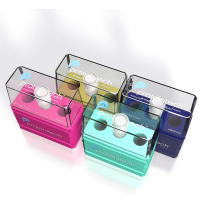Correlative Microscopy of Ultrathin Cryosections in Placental Research
互联网
445
In this chapter, we describe procedures for correlative microscopy in immunocytochemical studies on the human placenta. We have adapted ultrathin cryosections for use in high-resolution immunofluorescence microscopy (IFM) and for correlative immunocytochemical localization using fluorescence and electron microscopy. High-resolution IFM of ultrathin cryosections (50–100 nm in thickness) can be important because these physical sections minimize the potential for false co-localization in the z-dimension. In addition, IFM of these sections affords greater sampling efficiency than does immunoelectron microscopy (IEM). These ultrathin cryosections are compatible with conventional electron microscopy because a relatively low-voltage electron beam can penetrate them. Thus, the same ultrathin cryosections of placenta can be viewed in both fluorescence and electron microscopes. This latter point can be of importance because it may be necessary to know the true size and shape of objects observed by IFM; this can be determined best by IEM. Additionally, IEM can provide the “reference space” lacking in IFM. The use of ultrathin cryosections is a powerful approach for placental research, especially for the investigation of the in situ localization of antigens in the complex structure of the human placenta.









